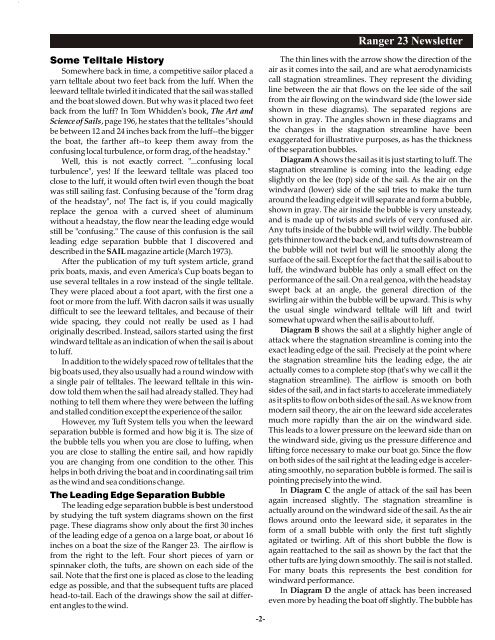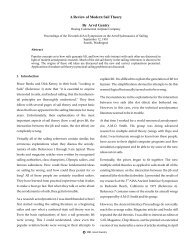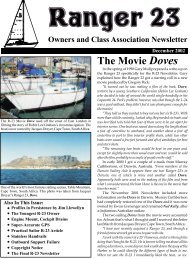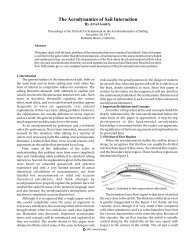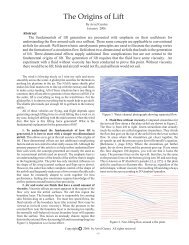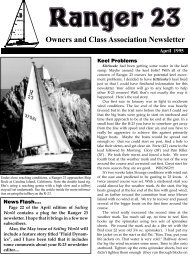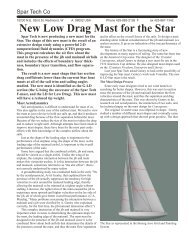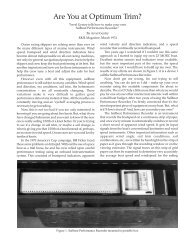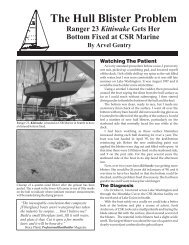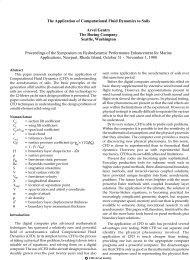Sailing to Windward With the Gentry Tuft System - ArvelGentry.com
Sailing to Windward With the Gentry Tuft System - ArvelGentry.com
Sailing to Windward With the Gentry Tuft System - ArvelGentry.com
Create successful ePaper yourself
Turn your PDF publications into a flip-book with our unique Google optimized e-Paper software.
.<br />
Some Telltale His<strong>to</strong>ry<br />
Somewhere back in time, a <strong>com</strong>petitive sailor placed a<br />
yarn telltale about two feet back from <strong>the</strong> luff. When <strong>the</strong><br />
leeward telltale twirled it indicated that <strong>the</strong> sail was stalled<br />
and <strong>the</strong> boat slowed down. But why was it placed two feet<br />
back from <strong>the</strong> luff? In Tom Whidden's book, The Art and<br />
Science of Sails, page 196, he states that <strong>the</strong> telltales "should<br />
be between 12 and 24 inches back from <strong>the</strong> luff--<strong>the</strong> bigger<br />
<strong>the</strong> boat, <strong>the</strong> far<strong>the</strong>r aft--<strong>to</strong> keep <strong>the</strong>m away from <strong>the</strong><br />
confusing local turbulence, or form drag, of <strong>the</strong> headstay."<br />
Well, this is not exactly correct. "...confusing local<br />
turbulence", yes! If <strong>the</strong> leeward telltale was placed <strong>to</strong>o<br />
close <strong>to</strong> <strong>the</strong> luff, it would often twirl even though <strong>the</strong> boat<br />
was still sailing fast. Confusing because of <strong>the</strong> "form drag<br />
of <strong>the</strong> headstay", no! The fact is, if you could magically<br />
replace <strong>the</strong> genoa with a curved sheet of aluminum<br />
without a headstay, <strong>the</strong> flow near <strong>the</strong> leading edge would<br />
still be "confusing." The cause of this confusion is <strong>the</strong> sail<br />
leading edge separation bubble that I discovered and<br />
described in <strong>the</strong> SAIL magazine article (March 1973).<br />
After <strong>the</strong> publication of my tuft system article, grand<br />
prix boats, maxis, and even America's Cup boats began <strong>to</strong><br />
use several telltales in a row instead of <strong>the</strong> single telltale.<br />
They were placed about a foot apart, with <strong>the</strong> first one a<br />
foot or more from <strong>the</strong> luff. <strong>With</strong> dacron sails it was usually<br />
difficult <strong>to</strong> see <strong>the</strong> leeward telltales, and because of <strong>the</strong>ir<br />
wide spacing, <strong>the</strong>y could not really be used as I had<br />
originally described. Instead, sailors started using <strong>the</strong> first<br />
windward telltale as an indication of when <strong>the</strong> sail is about<br />
<strong>to</strong> luff.<br />
In addition <strong>to</strong> <strong>the</strong> widely spaced row of telltales that <strong>the</strong><br />
big boats used, <strong>the</strong>y also usually had a round window with<br />
a single pair of telltales. The leeward telltale in this window<br />
<strong>to</strong>ld <strong>the</strong>m when <strong>the</strong> sail had already stalled. They had<br />
nothing <strong>to</strong> tell <strong>the</strong>m where <strong>the</strong>y were between <strong>the</strong> luffing<br />
and stalled condition except <strong>the</strong> experience of <strong>the</strong> sailor.<br />
However, my <strong>Tuft</strong> <strong>System</strong> tells you when <strong>the</strong> leeward<br />
separation bubble is formed and how big it is. The size of<br />
<strong>the</strong> bubble tells you when you are close <strong>to</strong> luffing, when<br />
you are close <strong>to</strong> stalling <strong>the</strong> entire sail, and how rapidly<br />
you are changing from one condition <strong>to</strong> <strong>the</strong> o<strong>the</strong>r. This<br />
helps in both driving <strong>the</strong> boat and in coordinating sail trim<br />
as <strong>the</strong> wind and sea conditions change.<br />
The Leading Edge Separation Bubble<br />
The leading edge separation bubble is best unders<strong>to</strong>od<br />
by studying <strong>the</strong> tuft system diagrams shown on <strong>the</strong> first<br />
page. These diagrams show only about <strong>the</strong> first 30 inches<br />
of <strong>the</strong> leading edge of a genoa on a large boat, or about 16<br />
inches on a boat <strong>the</strong> size of <strong>the</strong> Ranger 23. The airflow is<br />
from <strong>the</strong> right <strong>to</strong> <strong>the</strong> left. Four short pieces of yarn or<br />
spinnaker cloth, <strong>the</strong> tufts, are shown on each side of <strong>the</strong><br />
sail. Note that <strong>the</strong> first one is placed as close <strong>to</strong> <strong>the</strong> leading<br />
edge as possible, and that <strong>the</strong> subsequent tufts are placed<br />
head-<strong>to</strong>-tail. Each of <strong>the</strong> drawings show <strong>the</strong> sail at different<br />
angles <strong>to</strong> <strong>the</strong> wind.<br />
-2-<br />
Ranger 23 Newsletter<br />
The thin lines with <strong>the</strong> arrow show <strong>the</strong> direction of <strong>the</strong><br />
air as it <strong>com</strong>es in<strong>to</strong> <strong>the</strong> sail, and are what aerodynamicists<br />
call stagnation streamlines. They represent <strong>the</strong> dividing<br />
line between <strong>the</strong> air that flows on <strong>the</strong> lee side of <strong>the</strong> sail<br />
from <strong>the</strong> air flowing on <strong>the</strong> windward side (<strong>the</strong> lower side<br />
shown in <strong>the</strong>se diagrams). The separated regions are<br />
shown in gray. The angles shown in <strong>the</strong>se diagrams and<br />
<strong>the</strong> changes in <strong>the</strong> stagnation streamline have been<br />
exaggerated for illustrative purposes, as has <strong>the</strong> thickness<br />
of <strong>the</strong> separation bubbles.<br />
Diagram A shows <strong>the</strong> sail as it is just starting <strong>to</strong> luff. The<br />
stagnation streamline is <strong>com</strong>ing in<strong>to</strong> <strong>the</strong> leading edge<br />
slightly on <strong>the</strong> lee (<strong>to</strong>p) side of <strong>the</strong> sail. As <strong>the</strong> air on <strong>the</strong><br />
windward (lower) side of <strong>the</strong> sail tries <strong>to</strong> make <strong>the</strong> turn<br />
around <strong>the</strong> leading edge it will separate and form a bubble,<br />
shown in gray. The air inside <strong>the</strong> bubble is very unsteady,<br />
and is made up of twists and swirls of very confused air.<br />
Any tufts inside of <strong>the</strong> bubble will twirl wildly. The bubble<br />
gets thinner <strong>to</strong>ward <strong>the</strong> back end, and tufts downstream of<br />
<strong>the</strong> bubble will not twirl but will lie smoothly along <strong>the</strong><br />
surface of <strong>the</strong> sail. Except for <strong>the</strong> fact that <strong>the</strong> sail is about <strong>to</strong><br />
luff, <strong>the</strong> windward bubble has only a small effect on <strong>the</strong><br />
performance of <strong>the</strong> sail. On a real genoa, with <strong>the</strong> headstay<br />
swept back at an angle, <strong>the</strong> general direction of <strong>the</strong><br />
swirling air within <strong>the</strong> bubble will be upward. This is why<br />
<strong>the</strong> usual single windward telltale will lift and twirl<br />
somewhat upward when <strong>the</strong> sail is about <strong>to</strong> luff.<br />
Diagram B shows <strong>the</strong> sail at a slightly higher angle of<br />
attack where <strong>the</strong> stagnation streamline is <strong>com</strong>ing in<strong>to</strong> <strong>the</strong><br />
exact leading edge of <strong>the</strong> sail. Precisely at <strong>the</strong> point where<br />
<strong>the</strong> stagnation streamline hits <strong>the</strong> leading edge, <strong>the</strong> air<br />
actually <strong>com</strong>es <strong>to</strong> a <strong>com</strong>plete s<strong>to</strong>p (that's why we call it <strong>the</strong><br />
stagnation streamline). The airflow is smooth on both<br />
sides of <strong>the</strong> sail, and in fact starts <strong>to</strong> accelerate immediately<br />
as it splits <strong>to</strong> flow on both sides of <strong>the</strong> sail. As we know from<br />
modern sail <strong>the</strong>ory, <strong>the</strong> air on <strong>the</strong> leeward side accelerates<br />
much more rapidly than <strong>the</strong> air on <strong>the</strong> windward side.<br />
This leads <strong>to</strong> a lower pressure on <strong>the</strong> leeward side than on<br />
<strong>the</strong> windward side, giving us <strong>the</strong> pressure difference and<br />
lifting force necessary <strong>to</strong> make our boat go. Since <strong>the</strong> flow<br />
on both sides of <strong>the</strong> sail right at <strong>the</strong> leading edge is accelerating<br />
smoothly, no separation bubble is formed. The sail is<br />
pointing precisely in<strong>to</strong> <strong>the</strong> wind.<br />
In Diagram C <strong>the</strong> angle of attack of <strong>the</strong> sail has been<br />
again increased slightly. The stagnation streamline is<br />
actually around on <strong>the</strong> windward side of <strong>the</strong> sail. As <strong>the</strong> air<br />
flows around on<strong>to</strong> <strong>the</strong> leeward side, it separates in <strong>the</strong><br />
form of a small bubble with only <strong>the</strong> first tuft slightly<br />
agitated or twirling. Aft of this short bubble <strong>the</strong> flow is<br />
again reattached <strong>to</strong> <strong>the</strong> sail as shown by <strong>the</strong> fact that <strong>the</strong><br />
o<strong>the</strong>r tufts are lying down smoothly. The sail is not stalled.<br />
For many boats this represents <strong>the</strong> best condition for<br />
windward performance.<br />
In Diagram D <strong>the</strong> angle of attack has been increased<br />
even more by heading <strong>the</strong> boat off slightly. The bubble has


